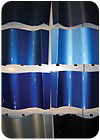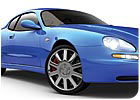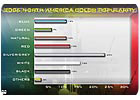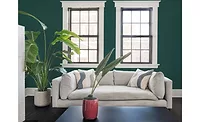Feeling Blue
While silver continues to be a popular color in the automotive industry, blue is expected to capture an increasing market share in the coming years.

The color silver has topped the automotive color charts once again this year, maintaining its supremacy as the most popular car color in North America. But in the future it will take on a fresh appearance as blues, browns and greens start to surge and become infused with silver to create a new look, according to a 2006 color popularity survey from PPG Industries.
Silver surpassed all colors among North American vehicles produced in the 2006 model year with 24%, down 2% from last year. Silver also remained the leading color for 2006 in all North American vehicle segments, with the highest share (29%) in the luxury category.
“Silver remains number one, but it’s evolving beyond the old parameters,” said Jane E. Harrington, manager, color styling, automotive coatings for PPG. “We’re going to see more graphite hues, and silver will shift to become a more complex color with subtle undertone tints of brown, blue, green and gold.
“Silver is going to remain popular. It’s a preferred hue because it defines character lines and features on the exterior of a vehicle better than a darker color,” she added. “But blue is going to start grabbing some of silver’s market share. Both pure tones and light values of blue are going to be strong, emerging color trends within the next few years.”
Additional research conducted by PPG revealed that for the 2006 model year in North America, white was the second most popular color at 16%, holding steady from last year. Black and red tied for third at 13% each, followed by blue at 12%. Naturals, which include light metallic beige, copper, orange and brown, also came in at 12%. Green captured 7%, and niche and specialty colors accounted for 3% (see Figure 1).

“In addition to blue, the natural color family is going to be an area of growth for the automotive market,” Harrington said. “This new trend is based on the consumer’s desire for handcrafted-looking products that are authentic and exclusive.”
Harrington said she believes brighter colors are working their way back after years of silver, black and white dominating the popularity charts. “Color is one of the first things someone notices about a vehicle. It redefines the shape and styling of a car and brings it to life,” she said. “We see color inching back into the mainstream. Hues are being reinvented as they’re influenced by new shades, new coating technologies and special effects.”
Harrington also noted that the trend away from large SUVs and trucks will present new opportunities for specialized finishes. “We’re seeing brighter colors, two-tone finishes and a greater variety of finishes in the small-vehicle market,” she said.
The color experts at PPG are forecasting the following North American color trends for the 2009-2010 model years:

“Aluminum flakes continue to be a major component of new colors due to their brightness and size variety. They allow us to formulate colors with exceptional travel and remarkable effect,” said Jerry R. Koenigsmark, manager of color design, North America, automotive coatings for PPG. Another creative approach is the tri-coat process, in which a layer of clearcoat is applied over a pigmented layer of mid-coat and a solid or metallic base coat. “We’re developing a more colorful mid-coat layer which we’re hoping will open up a whole new technology palette to designers,” Koenigsmark said.
Other technology advances are also in the works that will enable automotive manufacturers to become more competitive and differentiate their finishes from others on the market. For example, PPG is developing color key primers that will allow finishers to achieve the same quality with less film; glass flake finishes that offer higher durability and scratch resistance than conventional clears; and finishes based on nanotechnology, which will offer more transparent, richer colors and low gloss colors with high mar and scratch resistance. While such technologies aren’t likely to find their way into automotive finishes until the 2011-2012 model year and beyond, they’re a clear indication that innovation continues to thrive in the automotive finishing sector.
For more information, contact Leslie Dagg at 248.269.1122 or ldagg@bianchipr.com. PPG’s website is at www.ppg.com.

Both pure tones and light values of blue are going to be strong, emerging color trends within the next few years.
The color silver has topped the automotive color charts once again this year, maintaining its supremacy as the most popular car color in North America. But in the future it will take on a fresh appearance as blues, browns and greens start to surge and become infused with silver to create a new look, according to a 2006 color popularity survey from PPG Industries.
Silver surpassed all colors among North American vehicles produced in the 2006 model year with 24%, down 2% from last year. Silver also remained the leading color for 2006 in all North American vehicle segments, with the highest share (29%) in the luxury category.
“Silver remains number one, but it’s evolving beyond the old parameters,” said Jane E. Harrington, manager, color styling, automotive coatings for PPG. “We’re going to see more graphite hues, and silver will shift to become a more complex color with subtle undertone tints of brown, blue, green and gold.
“Silver is going to remain popular. It’s a preferred hue because it defines character lines and features on the exterior of a vehicle better than a darker color,” she added. “But blue is going to start grabbing some of silver’s market share. Both pure tones and light values of blue are going to be strong, emerging color trends within the next few years.”
Additional research conducted by PPG revealed that for the 2006 model year in North America, white was the second most popular color at 16%, holding steady from last year. Black and red tied for third at 13% each, followed by blue at 12%. Naturals, which include light metallic beige, copper, orange and brown, also came in at 12%. Green captured 7%, and niche and specialty colors accounted for 3% (see Figure 1).

New Colors for the 2009-2010 Model Year
The PPG Global Design and Color Marketing Team, which consists of colorists in North America, South America, Germany, Italy, Japan, South Korea, China, Malaysia, India and Australia, developed 110 new concept colors for consideration by automotive designers for the 2009-2010 model years. The colors were recently unveiled to automakers as part of PPG’s annual color show.“In addition to blue, the natural color family is going to be an area of growth for the automotive market,” Harrington said. “This new trend is based on the consumer’s desire for handcrafted-looking products that are authentic and exclusive.”
Harrington said she believes brighter colors are working their way back after years of silver, black and white dominating the popularity charts. “Color is one of the first things someone notices about a vehicle. It redefines the shape and styling of a car and brings it to life,” she said. “We see color inching back into the mainstream. Hues are being reinvented as they’re influenced by new shades, new coating technologies and special effects.”
Harrington also noted that the trend away from large SUVs and trucks will present new opportunities for specialized finishes. “We’re seeing brighter colors, two-tone finishes and a greater variety of finishes in the small-vehicle market,” she said.
The color experts at PPG are forecasting the following North American color trends for the 2009-2010 model years:
- Blue: The color blue will increase in popularity, with updated rich classic blues featuring sparkle effects for a unique iridescence and some shades featuring green and red casts. Medium-valued blues with silver highlights also add new dimension to the palette.
- Green: Nature-inspired textures and patterns will expand the range of greens, especially with continued consumer interest in the environment and “green” products. The color will be enhanced with a light, almost translucent hue on one end of the spectrum, while a combination of green with brown will create a new dark khaki on the other.
- Naturals: The metallic looks seen in fashion, packaging and product design are strong influences on the natural color family. Medium values will showcase subtle tones of copper and bronze, while special-effect pigments will help create contemporary and luxurious browns influenced by wood and leather products.
- Red: This classic color palette will be highly influenced by interior design, resulting in deep burgundies and bright, saturated reds. With new effect pigments, the depth and brilliance of red can be expanded.
- Neutrals: Comprised of silvers, blacks and whites, the neutral family has strong ties to fashion. Blacks with metallic effects will be the new focus. Tonal whites and pearl colors will continue to become established. Silvers will continue to develop with the addition of metallic flake and effect pigments, while a move to darker graphite colors with slight tints of brown and green will add new interest.

Figure 1. Silver surpassed all colors among North American vehicles produced in the 2006 model year.
Technology Advances
Recognizing that consumers yearn for the latest in technology in all aspects of their lives, PPG is turning to a more technology-focused, trend-infused showcase, inventing colors that show complexity under different lighting.“Aluminum flakes continue to be a major component of new colors due to their brightness and size variety. They allow us to formulate colors with exceptional travel and remarkable effect,” said Jerry R. Koenigsmark, manager of color design, North America, automotive coatings for PPG. Another creative approach is the tri-coat process, in which a layer of clearcoat is applied over a pigmented layer of mid-coat and a solid or metallic base coat. “We’re developing a more colorful mid-coat layer which we’re hoping will open up a whole new technology palette to designers,” Koenigsmark said.
Other technology advances are also in the works that will enable automotive manufacturers to become more competitive and differentiate their finishes from others on the market. For example, PPG is developing color key primers that will allow finishers to achieve the same quality with less film; glass flake finishes that offer higher durability and scratch resistance than conventional clears; and finishes based on nanotechnology, which will offer more transparent, richer colors and low gloss colors with high mar and scratch resistance. While such technologies aren’t likely to find their way into automotive finishes until the 2011-2012 model year and beyond, they’re a clear indication that innovation continues to thrive in the automotive finishing sector.
For more information, contact Leslie Dagg at 248.269.1122 or ldagg@bianchipr.com. PPG’s website is at www.ppg.com.
Looking for a reprint of this article?
From high-res PDFs to custom plaques, order your copy today!




